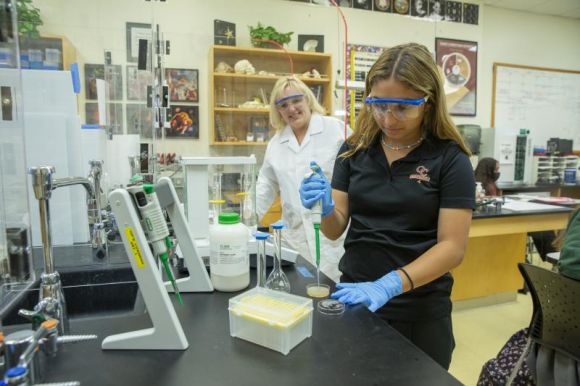"There is a time and place for 'set in stone' with appropriate consequences. But even during non-pandemic years, students struggle through adolescence, and compassion and flexibility could go a long way to helping those who struggle."
Julie Pugh, Author
A ship being thrown about while in a haze of fog, not knowing when we would find solid land and isolated except through electronic communications. A deep feeling of sadness, frustration, and sea sickness from the hours on Zoom that I cannot show because I am the captain of this ship.
My attitude toward adversity and adjustment to an environment that is less than ideal would be a lesson my students would learn on how to handle life’s difficult circumstances. My job expanded beyond teaching science, to being the lifeline for so many students who just needed to talk because they were afraid, or needed some structure to feel a sense of calm as they learned new ways to learn and were thrust into becoming more independent students.
I started with digital resources. Gizmos, Edulastic, Labster, Howard Hughes Medical Institute BioInteractive, and LabXchange were some of the sites that I spent hours on trying to find just the right thing to grab students’ attention and give them some sense of the scientific process. Many of these sites are invaluable, and I will continue to use them in the future, especially for a student who may be absent for a long period of time as an alternative to a wet lab. But honestly, it really wasn’t the virtual environments that gained their interest. It was a chance to explore away from the computer screen that became the best venue for learning.
I was fortunate enough to have a budget to put together a safe take-home lab kit that allowed each and every biology and biotechnology student to do six at-home experiments in the fall that had everything they would need. One was simple: diffusion across a cell membrane. The kit contained Dixie cups, sugar packets, spoons, carrots, ruler, graph paper, colored pencils. They could not measure the change by mass, and we could not make molar solutions for each student. But they could make solutions that had no sugar, or with 5, 10, 15, or 20 sugar packets, and they could then measure the change in diameter of a carrot. It allowed them to do parts of the scientific method, dependent and independent variables, graphing, analyzing data, collaborating, and drawing conclusions.
For biotechnology, we changed the order of units, gambling that we may be able to do some of the elegant transformation labs in the spring and did a longitudinal study on planaria and regeneration in conjunction with materials provided on the HHMI BioInteractive website. Each student’s kit contained two vials of planaria, a glass coverslip to “cut” the planaria, a cheap magnifying glass, and distilled water. Students loved the chance to learn “off-screen” and be the scientists of their own study as they also created their own science experiment as part of their final exam. One student wanted to know more about which temperature her tarantula preferred. Another wanted to know if the reason there were no weeds under his pepper tree was because the pepper seeds fell in that area. Maybe the necessity of learning from home allowed students to develop intangible skills of observation and curiosity that we skim over to get to the core curriculum.
Social–emotional learning has been a big buzzword that I knew was important, but that came into focus as not “just one more thing” to do in the classroom but “THE thing." Students struggled this year with emotional health and isolation from their friends and teachers. Once things opened up, I was able to get permission to drop off supplies at each student’s house and wave to them from a safe distance.
Flexibility was the key. There were no set-in-stone “deadlines;” a student who was clearly struggling with screen time could be given an extension. Students who had lost a loved one or who were concerned about grandparents could come in and talk and share through Zoom. Part of the students’ daily routines and requirements was to have a “greeter” each day that had to ask each person in class a fun or silly question. We all needed to laugh and bond, even though we had never seen each other face to face.
There is a time and place for “set in stone” with appropriate consequences. But even during non-pandemic years, students struggle through adolescence, and compassion and flexibility could go a long way to helping those who struggle.
View other stories in the ABE Pandemic Teaching Stories series.
